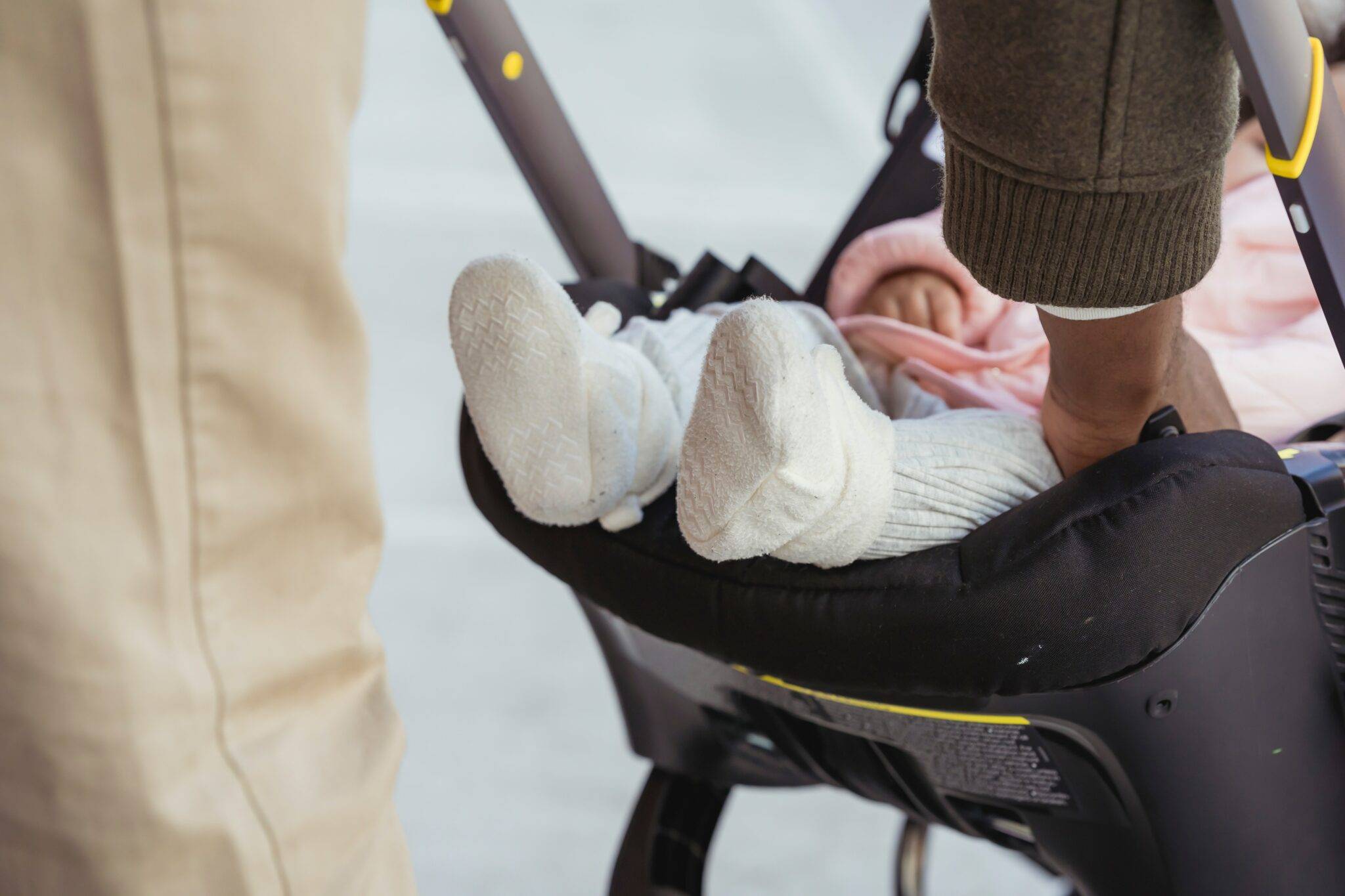Ensuring your baby gets enough restful sleep is the cornerstone of their growth, development, and happiness. As parents, establishing healthy sleep patterns early on sets the foundation for better sleep habits as they grow.
This comprehensive guide provides valuable tips and strategies to help you navigate this important aspect of parenting–develop healthy sleep patterns.
Understanding Your Baby’s Sleep Needs
Newborn Sleep Patterns
Newborns have unique sleep cycles that can be confusing and challenging for new parents. It quite differs from those of older babies and adults. Typically, newborns sleep 14-17 hours a day, but this sleep is spread out in short bursts, usually lasting 1-3 hours.
This frequent waking is necessary for regular feeding as their small stomachs can’t hold enough to keep them feeling full for long periods. Recognizing this natural sleep pattern helps you manage your expectations and plan a realistic sleep schedule.
It’s normal for newborns to wake up several times during the night, and recognizing this sleep pattern helps reduce stress and anxiety for new parents.
Sleep Cycles and Development
Babies go through various stages of sleep, including light (active) and deep (quiet) sleep. These cycles evolve as your baby grows, impacting their sleep patterns. Early on, babies spend a lot of time in REM (Rapid Eye Movement) sleep, which is essential for brain development.
Understanding these sleep patterns and stages helps you create an environment conducive to restful sleep.
1. Creating a Consistent Bedtime Routine
A consistent bedtime routine is crucial as it signals your baby that it’s time to sleep. This predictability provides comfort and helps your baby understand the transition from wakefulness to sleep. A well-established routine makes bedtime a peaceful and pleasant experience for you and your baby, and a healthy sleep pattern.
Steps to a Calming Bedtime Routine
- Bath Time: A warm bath can be very relaxing for your baby. It’s a great way to start the bedtime routine, helping to soothe and prepare them for sleep.
- Feeding: Ensure your baby is well-fed, but try not to feed them to sleep every time, as they might become dependent on this to fall asleep.
- Reading or Singing: Gentle storytelling or lullabies can be incredibly soothing. This quiet time allows you to bond with your baby and signals that it’s time to wind down.
- Dim the Lights: Lowering the lights in the room can help your baby understand that it’s time to prepare for sleep. The darkness helps to stimulate the production of melatonin, the sleep hormone.
2. Recognizing Sleep Cues
Learn to recognize your baby’s sleep cues, such as rubbing eyes, yawning, or becoming fussy. Responding to these cues promptly prevents overtiredness and makes it easier for your baby to fall asleep. Over time, this will create a healthy sleep pattern.
Creating a Calm Pre-Sleep Routine: Develop a pre-sleep routine that helps your baby transition from wakefulness to sleep. This routine includes calming activities and consistent cues that signal it’s time to sleep.
3. Encouraging Self-Soothing
Self-soothing skills allow your baby to fall asleep independently and return to sleep during night wakings without needing much intervention. Over time, you may not realize it your baby is developing a healthy sleep pattern.
Techniques to Encourage Self-Soothing
- Gradual Approach: Gradually reduce the comfort you provide during night wakings. Over time, your baby learns to settle without your help.
- Comfort Object: Introduce a small, safe comfort object like a blanket or soft toy the baby can hold. This provides a sense of security and helps with self-soothing.
- Wait and Observe: Give your baby a few minutes to settle on their own before intervening. Sometimes, they fuss briefly but return to sleep without your assistance.
4. Creating a Sleep-Inducing Environment
- Ideal Room Temperature: The baby’s room temperature significantly affects their sleep quality, and also sleep pattern. Maintaining a comfortable room temperature, typically between 68-72°F (20-22°C), helps prevent your baby from becoming too hot or cold, which disturbs their sleep.
- Noise and Light Control: Create a dark and quiet sleep environment. Use blackout curtains to keep the room dark and a white noise machine to mask disruptive sounds. This setup helps your baby associate darkness with sleep time and minimize waking up due to external noises.
5. Promoting Daytime and Nighttime Differences
Helping your baby distinguish between day and night is essential in establishing a healthy sleep pattern. During the day, keep your home bright and engage in stimulating activities. At night, keep the lights dim and interactions calm. This contrast helps your baby learn that nighttime is for sleeping and daytime is for activity.
Nap Time Management: Naps are crucial for your baby’s development, but managing nap times is equally important. Avoid letting your baby nap too long or too close to bedtime, as it can interfere with their ability to sleep at night. Aim for regular nap times during the day to keep your baby well-rested and prevent overtiredness.
6. Handling Sleep Regression
Sleep regression is a temporary phase where a baby who previously slept well suddenly starts waking up frequently at night. This sleep pattern occurs during developmental milestones, such as learning to crawl or teethe, or due to changes in routine.
Coping with Sleep Regression
Consistency is key during sleep regressions. Maintain your established bedtime routine and be patient. Comfort your baby as needed, but avoid introducing new sleep habits that might be difficult to break later. This phase is temporary, and maintaining consistency helps your baby return to their usual sleep pattern.
7. Safe Sleep Practices
- Back to Sleep: To reduce the risk of Sudden Infant Death Syndrome (SIDS), always place your baby on their back to sleep. This is the safest position for infants, significantly decreasing the risk of SIDS.
- Safe Sleep Environment: Creating a safe sleep environment is critical. Ensure the crib is free of loose bedding, pillows, and toys, which can pose a suffocation hazard. Use a firm mattress with a fitted sheet, and avoid using soft, plush bedding items in the crib.
8. Responding to Night Wakings
It’s normal for babies to wake up during the night. They need feeding, a diaper change, or simply some comfort. Over time, most babies learn to self-soothe and return to sleep without parental intervention.
Soothing Techniques: When your baby wakes up at night, gentle soothing techniques help them settle back to sleep. Patting, shushing, or offering a pacifier can be effective. Avoid picking your baby up every time they wake up, as this creates a dependency that’s hard to break later.
9. Addressing Common Sleep Challenges
- Colic and Sleep: Colic makes it difficult for babies to sleep due to discomfort and excessive crying. Swaddling, rocking, and white noise techniques help soothe a colicky baby and promote better sleep.
- Teething and Sleep: Teething can be challenging as it often disrupts sleep due to discomfort. Offering a chilled teething ring or gently massaging your baby’s gums before bedtime helps alleviate some pain and make it easier for them to sleep.
10. Building Good Sleep Associations
- Positive Sleep Associations: Creating positive associations helps your baby develop healthy sleep habits. These associations include specific bedtime cues like a blanket, a lullaby, or a consistent sleep position.
- Avoiding Negative Associations: Be cautious of forming negative sleep associations, such as always feeding or rocking your baby to sleep. While these can be comforting, they may lead to dependency and make it harder for your baby to fall asleep independently.
11. Monitoring and Adjusting Sleep Schedules
Keep a sleep diary to help monitor your baby’s sleep patterns and identify any issues. Note the times your baby sleeps, wakes up, and any night wakings. This information helps adjust bedtime and nap schedules according to your baby’s needs.
Flexible Yet Consistent: While it’s important to maintain consistency in your baby’s sleep routine, be flexible and adjust as your baby grows and their sleep needs change. Babies go through different phases, and their sleep requirements evolve.
12. Additional Tips for Better Sleep
- Baby Massage: Gentle massage relaxes your baby and promotes better sleep. Use baby-safe oils and gentle strokes to create a soothing experience.
- Swaddling: Swaddling helps newborns feel secure and sleep better. Ensure the swaddle is snug but not too tight, allowing room for hip movement.
- Pacifiers: Pacifiers provide comfort and help some babies sleep better. Ensure the pacifier is safe and appropriate for your baby’s age.
Encouraging Independence at Bedtime
- Gradual Separation: Encourage your baby to fall asleep independently by gradually reducing your presence at bedtime. Start by sitting next to the crib, then slowly move further away each night.
- Consistent Bedtime Routine: This helps your baby feel secure and understand that it’s time to sleep. This routine supports their ability to fall asleep independently.
Creating a Safe and Comfortable Sleep Environment
- Choosing the Right Crib: Ensure your baby’s crib meets safety standards and is free from hazards. The crib should have a firm mattress, and the slats should be close enough to prevent your baby from getting stuck. A safe crib environment is essential for your baby’s well-being.
- Appropriate Bedding: Use a fitted sheet and avoid loose bedding, pillows, or stuffed animals. These items pose suffocation risks. Keeping the crib simple and uncluttered ensures a safer sleep space for your baby.
The Impact of Physical Activity on Sleep
- Daytime Activity: Engage your baby in active play during the day to help them expend energy. Physical activity promotes better sleep and supports overall development.
- Calm Evenings: Keep evenings calm and quiet to help your baby wind down before bedtime. Avoid stimulating activities close to bedtime, as they interfere with your baby’s ability to fall asleep.
The Role of Nutrition in Sleep
- Feeding Schedule: Establish a feeding schedule that aligns with your baby’s sleep needs. Avoid heavy meals right before bedtime, as they can cause discomfort. A balanced feeding schedule supports better sleep patterns.
- Introducing Solids: When your baby is ready for solid foods, choose foods that are easy to digest and don’t cause discomfort. Introducing solids at the appropriate time helps your baby sleep more soundly.
Dealing with Nightmares and Night Terrors
Nightmares are common in older babies and young children. They usually occur during REM sleep and can cause your baby to wake up feeling scared.
- Handling Nightmares: Comfort your baby after a nightmare and reassure them they’re safe. Creating a calming bedtime routine helps prevent nightmares.
- Night Terrors: Night terrors differ from nightmares and occur in deep sleep. Your baby may seem awake but is still asleep. Avoid waking them and ensure their safety until the episode passes.
The Importance of Patience and Persistence
- Staying Consistent: Consistency is key when establishing healthy sleep patterns. Stick to your routine and be patient, even if progress seems slow.
- Adapting to Changes: Be prepared to adjust your routine as your baby grows and their sleep needs change. Flexibility and persistence help you navigate sleep challenges.
Professional Guidance and Support
If your baby’s sleep issues persist despite your best efforts, it may be time to seek professional help. Consult your pediatrician to rule out any underlying medical conditions and get additional strategies tailored to your baby’s needs.
Resources and Support Groups: Connecting with other parents and joining support groups provide valuable insights and encouragement. Sleep consultants in infant sleep offer personalized guidance to help your baby develop healthy sleep habits.
Establish Healthy Sleep Patterns for Your Baby
Establishing healthy sleep patterns for your baby is a journey that requires patience, consistency, and understanding. Help your baby develop good sleep habits that will benefit their growth and well-being. Remember, every baby is different, so find what works best for you and your little one.
For further reading on related topics, check out these articles from Omega Pediatrics:
- The Average Age of Children to Start Sleeping Through the Night and Tips for a Better Night’s Rest
- Helpful Tips to Put Your Newborn Baby to Sleep so You Can Get Some Rest Too
By following these tips and adapting to your baby’s needs, you’ll be on the path to establishing healthy sleep patterns that will help your baby enjoy restful nights and happier days.







